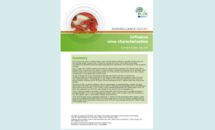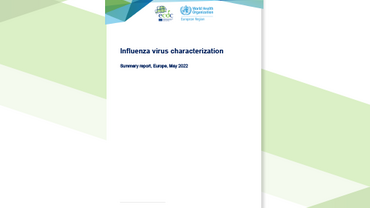Influenza virus characterisation, Summary Europe, July 2017
In the course of the 2016–17 influenza season, nearly 146 000 influenza detections have been reported across the WHO European Region. Influenza type A viruses have prevailed over type B, with A(H3N2) viruses greatly outnumbering A(H1N1)pdm09 and B/Yamagata-lineage detections (representing 73% of the type B viruses assigned to a lineage.)
Executive Summary
Since 1 January 2017, EU/EEA countries have shared 592 influenza-positive specimens with collection dates after 31 December 2016. Since the June 2017 report 97 viruses have been characterised antigenically and 34 genetically. Many A(H3N2) viruses could only be characterised genetically as HA titres of these viruses were too low to allow antigenic characterisation by haemagglutination inhibition assay.
All nine A(H1N1)pdm09 viruses characterised antigenically were similar to the 2016–17 vaccine virus, A/California/7/2009, and showed good reactivity with antiserum raised against the subclade 6B.1 2017–18 vaccine virus, A/Michigan/45/2015. The subclade 6B.1 viruses, defined by HA1 amino acid substitutions S162N and I216T, became dominant worldwide and the 19 EU/EEA viruses characterised with 2017 collection dates were all within this subclade.
Fifty-seven A(H3N2) viruses had sufficient HA titre for characterisation by haemagglutination inhibition (HI) assay. Approximately half (25/57) were recognised well by antiserum raised against egg-propagated A/Hong Kong/4801/2014 (the current vaccine component). Of 147 A(H3N2) viruses characterised genetically with collection dates in 2017, 38 (26%) were subclade 3C.2a, 108 (73%) were subclade 3C.2a1, and one (1%) was subclade 3C.3a.
Of the 13 B/Victoria-lineage viruses tested, all were antigenically similar to tissue culture-propagated surrogates of B/Brisbane/60/2008. All 33 viruses characterised with collection dates in 2017, including viruses with the deletion in HA1, fell in genetic clade 1A, as do recently collected viruses worldwide.
Of the 18 B/Yamagata viruses characterised antigenically, 17 reacted well with post-infection ferret antiserum raised against egg-propagated B/Phuket/3073/2013, the recommended vaccine virus for the northern hemisphere 2015–16 influenza season and for quadrivalent vaccines since 2016. Of the 65 viruses characterised with 2017 collection dates, all fell in genetic clade 3.
Download






